engine overheat PONTIAC BONNEVILLE 1997 User Guide
[x] Cancel search | Manufacturer: PONTIAC, Model Year: 1997, Model line: BONNEVILLE, Model: PONTIAC BONNEVILLE 1997Pages: 405, PDF Size: 18.83 MB
Page 233 of 405
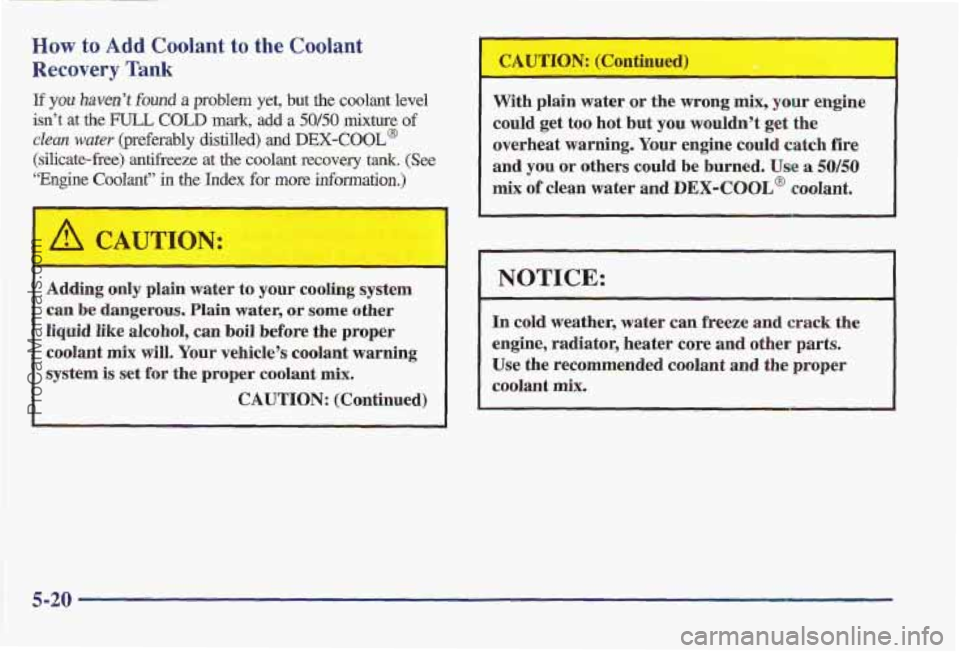
How to Add Coolant to the Coolant
Recovery Tank
If you haven’t found a problem yet, but the coolant level
isn’t
at the FULL COLD mark, add a 50/50 mixture of
clean water (preferably distilled) and DEX-COOL@
(silicate-free) antifreeze at the coolant recovery tank. (See
“Engine Coolant” in the Index for more information.)
With plain water or the wrong mix, your engine
could get too hot but
you wouldn’t get the
overheat warning.
Your engine could catch fire
and you or others could be burned. Use a 50/58
mix of clean water and DEX-COOL@ coolant.
r--- Adding only plain water to your cooling system 1 c NOTICE:
can be dangerous. Plain water, or some o’ther
liquid like alcohol,
can boil before the proper
coolant mix will. Your vehicle’s coolant warning
system is set for the proper coolant mix,
In cold weather, water can freeze and crack the
engine, radiator, heater core and other
parts.
Use
the recommended coolant and the proper
coolant mix.
CAUTION: (Continued)
5-20
ProCarManuals.com
Page 234 of 405
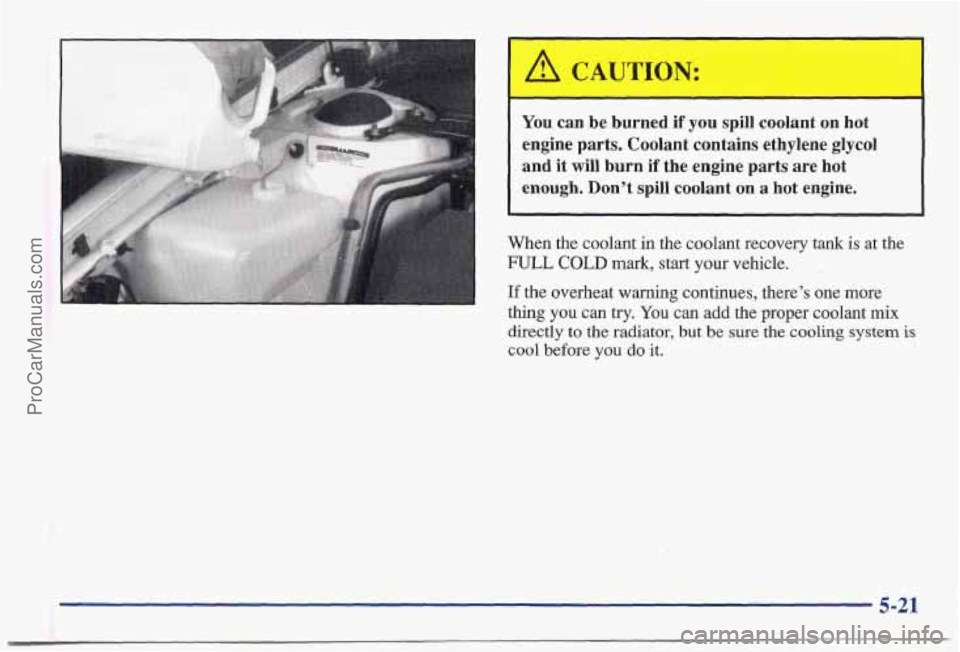
You can be burned if you spill coolant on hot
engine parts. Coolant contains ethylene
glycol
and it will burn if the engine parts are hot
enough. Don’t spill coolant on a hot engine.
L
When the coolant in the coolant recovery tank is at the
FULL COLD mark, start your vehicle.
If the overheat warning continues, there’s one more
thing
you can try. You can add the proper coolant mix
directly to the radiator, but be sure the cooling system is
cool before you do it.
5-21
ProCarManuals.com
Page 252 of 405
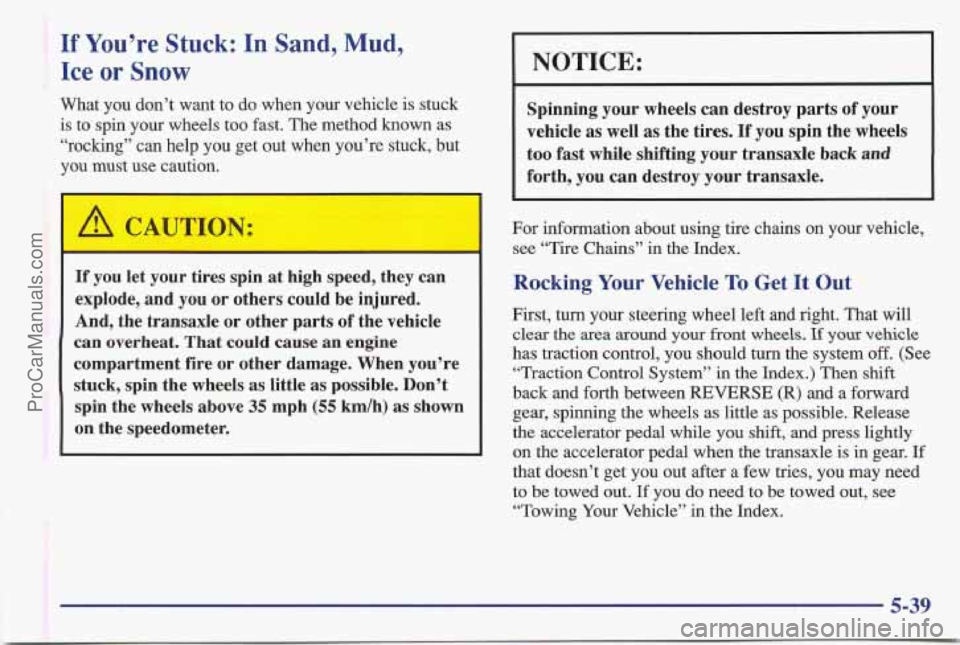
If You’re Stuck: In Sand, Mud,
Ice
or Snow
What you don’t want to do when your vehicle is stuck
is to spin your wheels too fast. The method known as
“rocking” can help you get out when you’re stuck, but
you must use caution.
c --
/L CAUTION:
1
If you let your tires spin at high speed, they can
explode, and you or others could be injured.
And, the transaxle or other parts of the vehicle
can overheat. That could cause an engine
compartment fire or other damage. When you’re
stuck, spin the wheels as little as possible. Don’t
spin the wheels above
35 mph (55 km/h) as shown
on the speedometer.
1 NOTICE: I
Spinning your wheels can destroy parts of your
vehicle
as well as the tires. If you spin the wheels
too fast while shifting your transaxle back
and
forth, you can destroy your transaxle.
For information about using tire chains on your vehicle,
see
“Tire Chains” in the Index.
Rocking Your Vehicle To Get It Out
First, turn your steering wheel left and right. That will
clear
the area around your front wheels. If your vehicle
has traction control, you should turn the system off. (See
“Traction Control System” in the Index.) Then shift
back and forth between
REVERSE (R) and a forward
gear, spinning the wheels as little as possible. Release
the accelerator pedal while you shift, and press lightly
on the accelerator pedal when the transaxle is in gear. If
that doesn’t get you out after a few tries, you may need
to be towed out. If you do need to be towed out, see
“Towing Your Vehicle” in the Index.
5-39
ProCarManuals.com
Page 277 of 405
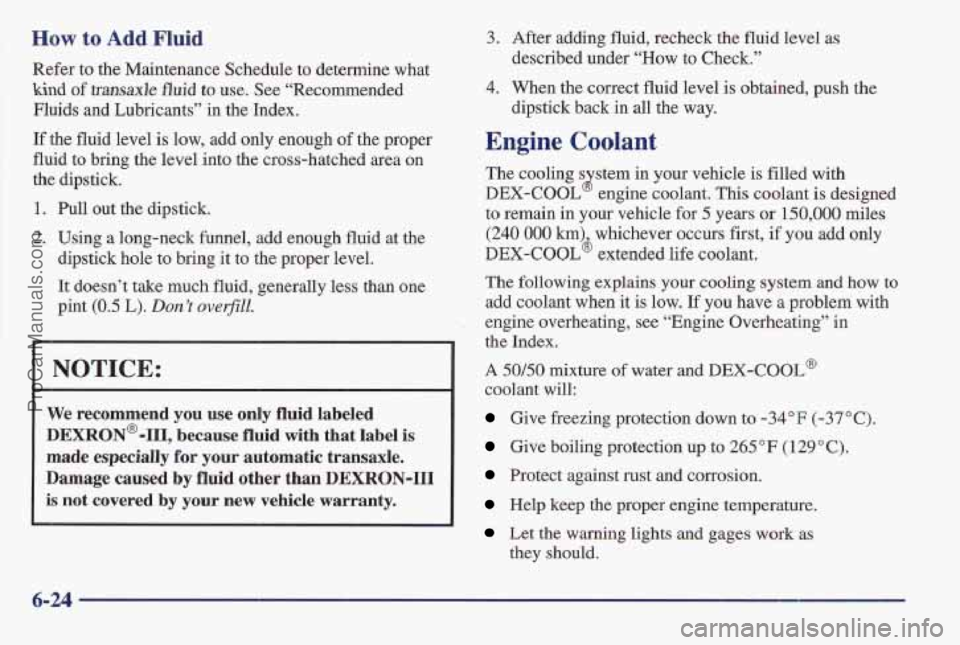
How to Add Fluid
Refer to the Maintenance Schedule to determine what
kind of transaxle fluid to use. See “Recommended
Fluids and Lubricants” in the Index.
If
the fluid level is low, add only enough of the proper
fluid to bring the level into the cross-hatched area on
the dipstick.
1. Pull out the dipstick.
2. Using a long-neck funnel, add enough fluid ,. @e
dipstick hole to bring it to’ the proper level.
It doesn’t take much fluid, generally less than one
pint
(0.5 L). Don’t overjU.
NOTICE:
We recommend you use only fluid labeled
DEXRON@-111, because fluid with that label i,s
made especially for your automatic transaxle.
Damage caused by fluid other than DEXRON-I11
is not covered by your new vehicle warranty.
3. After adding fluid, recheck the fluid level as
described under “How to Check.”
4. When the correct fluid level is obtained, push the
dipstick back in all the way.
Engine Coolant
The cooling s stem in your vehicle is filled with
DEX-COOL engine coolant. This coolant is designed
to remain in your vehicle for
5 years or 150,000 miles
(240 000 km) whichever occurs first, if you add only
DEX-COOL6 extended life coolant.
The following explains your cooling system and how to
add coolant when it is low. If you have ;e problem with
engine overheating, see “Engine Overheating” in
the
Index.
A 50J50 mixture of water and DEX-COOL@
coolant will:
Give freezing protection down to -34°F (-37°C).
Give boiling protection up to 2685 “F (129 O C).
Protect against rust and corrosion.
Help keep the proper engine temperature.
Llet the warning lights and gages work as
8
they should.
6-24
ProCarManuals.com
Page 278 of 405
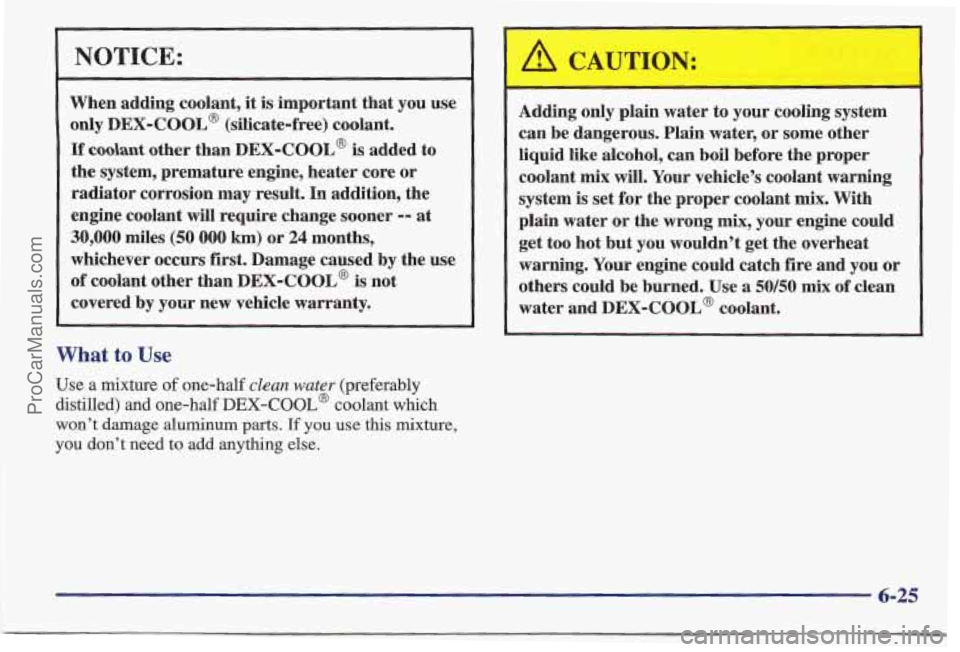
NOTICE:
When adding coolant, it is important that you use
only
DEX-COOL@ (silicate-free) coolant.
If coolant other than DEX-COOL@ is added to
the system, premature engine, heater core or
radiator corrosion may result.
In addition, the
engine coolant will require change sooner
-- at
30,000 miles (50 000 km) or 24 months,
whichever occurs first. Damage caused by the use
of coolant other than DEX-COOL@ is not
covered by your new vehicle warranty. Adding
only plain water to your cooling system
can be dangerous. Plain water, or some other
liquid like alcohol, can boil before the proper
coolant mix will. Your vehicle’s coolant warning
system is set for the proper coolant mix. With
plain water or the wrong mix, your engine could
get too hot but you wouldn’t get the overheat
warning. Your engine could catch fire and you or
others could be burned. Use a 50/50 mix of clean
water and DEX-COOL@ coolant.
What to Use
Use a mixture of one-half clean water (preferably
distilled) and one-half
DEX-COOL@ coolant which
won’t damage aluminum
parts. If you use this mixture,
you don’t need to add anything else.
6-25
ProCarManuals.com
Page 279 of 405
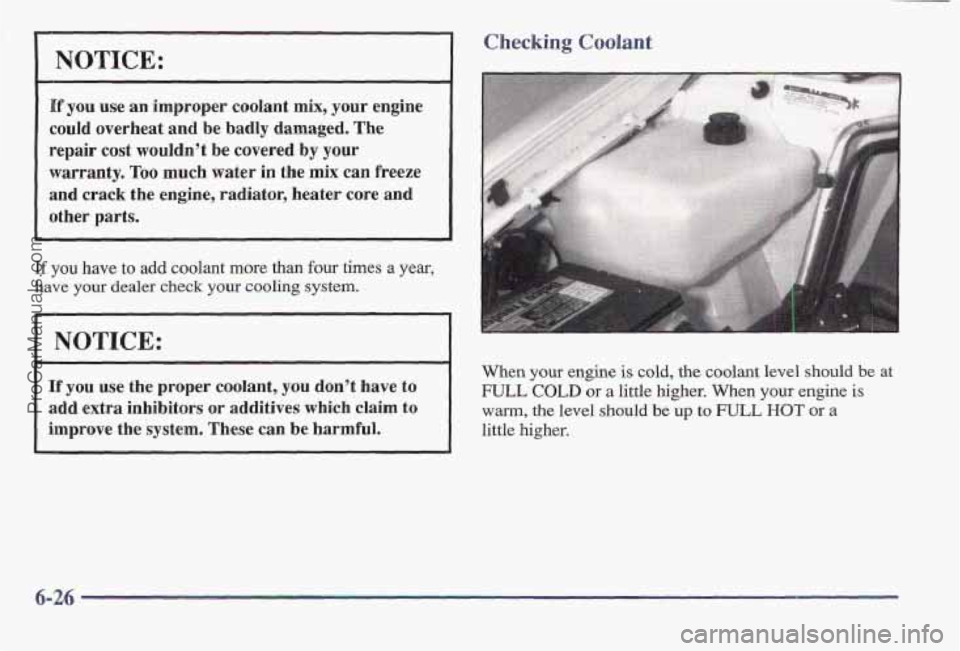
NOTICE:
If you use an improper coolant mix, your engine
could overheat and be badly damaged. The
repair cost wouldn’t
be covered by your
warranty, Too much water in the mix can freeze
and crack the engine, radiator, heater core and
other parts.
If you have to add coolant more than four times a year,
have your dealer check your cooling system.
NOTICE:
If you use the proper coolant, you don’t have t’o
add extra inhibitors or additives which claim to
improve the system. These can be harmful,
Checking Coolant
When your engine is cold, the coolant level should be at
FULL COLD or a little higher. When your engine is
warm, the level should be up to FULL HOT or a
little higher.
ProCarManuals.com
Page 280 of 405
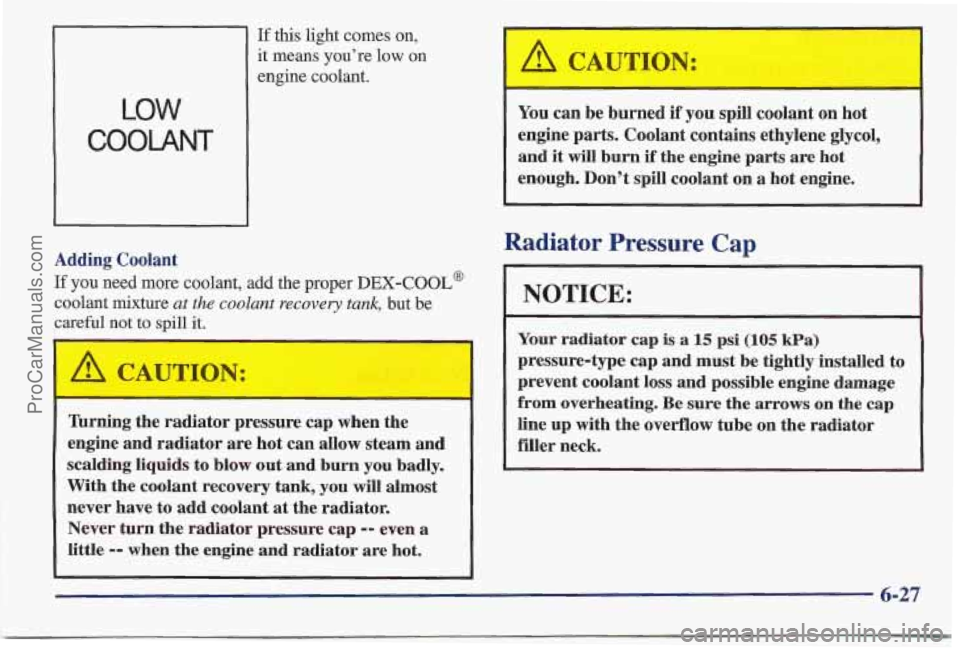
If this light comes on,
it means you’re low on
LOW
COOLANT
engine coolant.
Adding Coolant
If you need more coolant, add the proper DEX-COOL@
coolant mixture at the coolant recovery tank, but be
careful not to spill
it.
Turning the radiator pressure cap when the
engine and radiator are hot can allow steam and
scalding liquids to blow out and burn you badly.
With the coolant recovery tank, you will almost
never have to add coolant
at the radiator.
Never turn the radiator pressure cap
-- even a
little
-- when the engine and radiator are hot. You
can be
burned if you spill coolant on hot
engine parts. Coolant contains ethylene glycol,
and it will burn
if the engine parts are hot
enough. Don’t spill coolant on a hot engine.
Radiator Pressure Cap
NOTICE:
Your radiator cap is a 15 psi (105 kPa)
pressure-type cap and must be tightly installed to
prevent coolant loss and possible engine damage
from overheating. Be sure the arrows on the cap
line up with the overflow tube on the radiator
filler neck.
6-27
ProCarManuals.com